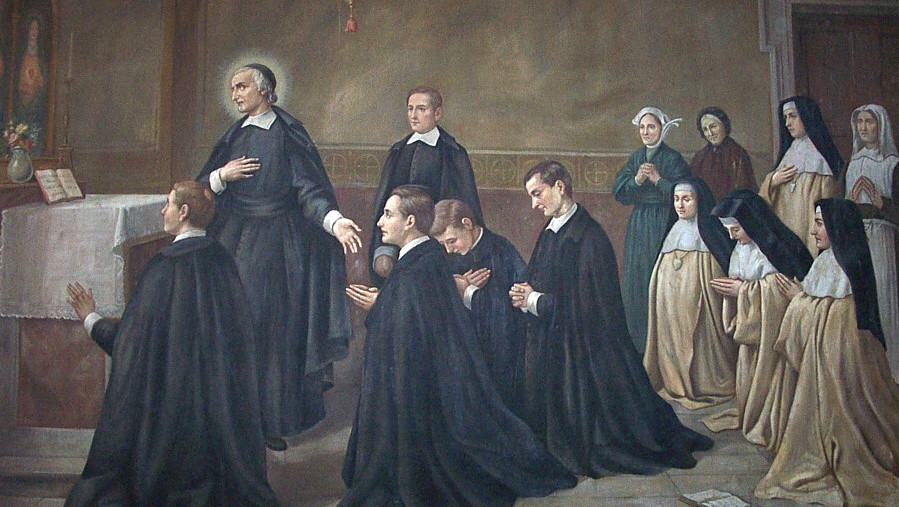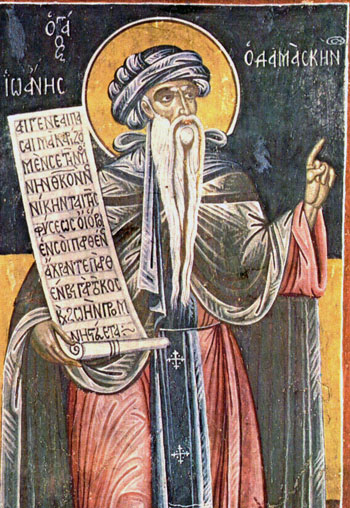



Telling them apart: So many Johns, part 2
Kristina Glicksman
Tuesday, August 18, 2020

Painting of St. John Eudes with fathers and sisters of the congregations he founded (Source: Wikimedia Commons)
Back in December we looked at two saints named John: St. John of Ávila (who wasn’t actually from Ávila) and St. John of the Cross (who was). And just for good measure, I threw in a couple of related, “bonus” Johns: St. John of God and St. Juan de Ribera.
It’s been a while, so why don’t we continue our journey of saints named John with a few you may have heard of but probably know nothing about. At least, that’s how it was for me before I looked them up!

John Eudes (1601-1680)
St. John Eudes was a priest who lived in northern France in the 17th century. He was the sort of person who saw a need and did his best to meet it. Concerned for the plight of women who wanted to leave a life of prostitution but found the cards stacked against them, he founded the Order of Our Lady of Charity as a refuge for them. Living in a time when education and spiritual formation were sadly lacking for both clergy and laity, he began by preaching missions, then moved to starting seminaries, and ended by founding the Congregation of Jesus and Mary (the Eudists), who still have as their double mission evangelization and education – that is, the formation of clergy and laity through seminaries and parish missions. What he is best known for, however, is his devotion to the Sacred Hearts of Jesus and Mary. Though the devotion had existed in a private, popular form for some time, it was through the efforts of St. John Eudes that it came to be celebrated in an official way as part of the Universal Church. Just one last story, a little thing that I probably wouldn’t have noticed six months ago but which definitely caught my eye now. When St. John Eudes was still a young priest, a plague broke out in the region where he was. He devoted himself to the care of the sick and burial of the dead, but to avoid bringing sickness home to his community (he was at that time a member of the French Oratory), he took up residence in a barrel in the middle of a field. A 19th-century account of his life records that for a long time after, the field was known as the “Saint’s meadow”. The Vatican’s Congregation for the Causes of Saints is currently evaluating a proposal to declare him a Doctor of the Church. If and when that happens, he will be the fifth John with that distinction. His feast day is August 19.O Heart of Jesus and Mary, inestimable treasure of manifold good, be my one treasure, my refuge and my protection! To you I have recourse in all my needs and necessities. When the hearts of all men deceive and abandon me, I have full confidence that the most precious and faithful Heart of my Loving Jesus and of His most sweet Mother will not deceive me and never will abandon me. – St. John Eudes, The Sacred Heart of Jesus
John Damascene (c.675/676-749)
In previous posts I have discussed three Doctors of the Church named John: St. John Chrysostom, St. John of Ávila, and St. John of the Cross. The fourth (and so far, final) John who rounds out the complement is St. John Damascene, or St. John of Damascus. As his name might suggest, this John was born and raised in Damascus. He was one of those early generations of Middle Eastern Christians who found themselves living under Muslim rule and in fact was one of the first Christian writers to address the subject of Islam. He came from a respected, influential, and well-to-do family, and it’s possible he started out on a career in local government like his father and grandfather before him, but we don’t know for certain. The thing is, the earliest biography we have for him was written at least a hundred years after his death and is extremely hagiographical. So while it’s entertaining to read about how the Virgin Mary restored his hand after he had lost it as punishment for a crime of which he was innocent, such stories not only are doubtful themselves but cast doubt on the rest of the biography so we don’t know which details to trust. What we do know is that he entered the monastery of Mar Saba, near Jerusalem, and spent the rest of his life there, writing hymns that are still used in Eastern Churches and a summary of Eastern theological thought which some consider to be the Eastern equivalent of St. Thomas Aquinas’ Summa Theologica. He is also famous for his involvement in the iconoclasm controversy of the time. In short, there was a great debate over whether images of Christ and other biblical figures should be venerated and even whether they should be made at all. This was a very heated and violent debate which resulted in the destruction of images and loss of life. John Damascene wrote three influential pieces defending the use of icons which were subsequently used in the Second Council of Nicaea in 787, which attempted to put the controversy to rest with only middling success. This round of iconoclasm faded out by the middle of the 9th century, but the fame of St. John Damascene and his writing endured. His feast day is December 4.
Painting of St. John Damascene holding a scroll with a hymn to the Virgin Mary by Michael Anagnostou Chomatzas (Source: Wikimedia Commons)
John Cassian (c.360-c.435)
No doubt you’ve heard of St. Benedict of Nursia, founder of Western monasticism and patron saint of Europe. But have you heard of St. John Cassian? If you don’t know about him, you probably should. You might say that St. John Cassian taught St. Benedict everything he knew. His case is an unusual one. Though he is greatly revered in the Eastern Churches, the Catholic Church has kind of swept him under the rug, and I’m not quite sure he deserves it. But I’m getting ahead of myself. More about that later. John Cassian was a wealthy, educated man. While he was still a youth, he travelled with a friend to Palestine and joined a monastery near Bethlehem. Seeking greater spiritual advancement, they left Palestine for the deserts of Egypt, where the famous Desert Fathers were living out their heroically eremitical lifestyle. After several years imbibing the spiritual atmosphere of these early monastic communities, Cassian ended up in Constantinople, where he was ordained a deacon and became a disciple of the Patriarch, John Chrysostom. When Chrysostom got kicked out of Constantinople (again!), Cassian was sent to Rome to try to get the pope to intervene. He seems to have been ordained a priest while in Rome and ended up in Marseilles, founding a double monastic community (one for men, one for women) along Eastern line – in contrast to the (comparatively) unruly Western practices inspired by St. Martin of Tours. And there he spent the rest of his life. This foundation had a great influence on the development of monasticism in the West, as did his two famous works recording the monastic lifestyle of the East and the sayings of the Desert Fathers. And they greatly inspired one young man in particular: Benedict of Nursia, whose rule – largely based on the work of John Cassian – provided the basis for the rules of several other orders besides his own highly influential one. So why isn’t he as celebrated in the West as he is in the East? Although Cassian was highly respected in his own day and for many generations after, his popularity eventually took a hit because of something questionable he wrote. Basically, it goes like this: There was at the time a popular heresy called Pelagianism, which claimed that we save ourselves through our own efforts (i.e., works not grace). Augustine of Hippo wrote against this heresy a lot, but at first he kind of went too far in the other direction (i.e., grace not works). Cassian joined the debate and attempted to correct Augustine (and in some sense he was justified because this argument of Augustine’s became a major platform of the Protestant Reformation). Unfortunately, he didn’t modify Pelagius’ stance enough and about a century after his death, Cassian’s thinking on this – or at least teachings which built on his thought – was declared a heresy under the name of Semipelagianism (which is not the same as saying that Cassian was a heretic). I kind of feel bad for him. He was respected and revered all through the Middle Ages. Then suddenly around the time of the Protestant Reformation and the Catholic Counter-Reformation, he fell out of favour and got “cancelled”. His feast was removed from the General Roman Calendar and is now only celebrated in specific areas, like Provence in France, where his monasteries were. But surely (and this is speaking as someone with only a very slight passing knowledge of Cassian), if his only mistake was in not being quite right while he was honestly searching for the truth, shouldn’t we honour him for that and look to him as an example? Sainthood isn’t about getting it right all the time, but it is about doing your best – with God’s grace. His feast day is July 23.Related Articles:
<<
SUPPORT LABEL
$50
$100
$150
$250
OTHER AMOUNT
DONATE
Receive our newsletters
Stay Connected
Receive our newsletters

Stay Connected







